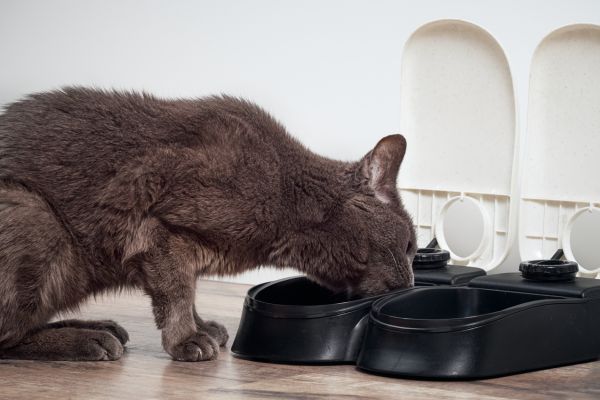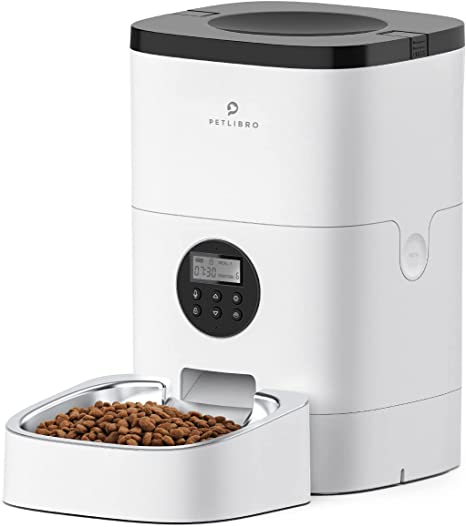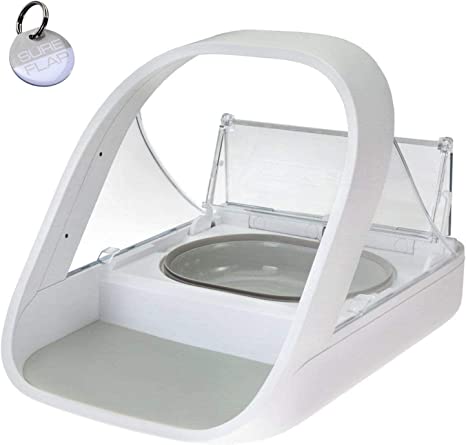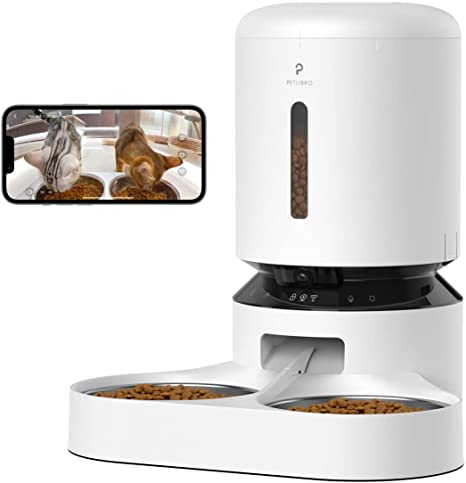In the movies, Garfield the cat, the overly plump feline who’s always in search of food and adventure, is great for a laugh.
In the real world, however, obesity in cats leads to unhealthiness, illness, and even death. Diabetes, arthritis, urinary obstruction, skin problems, and cancer are much more prevalent in obese cats than normal weight cats.
In the wild, cats spend most of their waking hours (not necessarily daylight hours) hunting for food, defending their territory, and caring for young or finding a mate. In today’s world, pet cats often get little exercise and find calories very easily in their dish – no hunting required.
That’s one reason why 59.5 percent of cats are overweight or obese, according to the 2021 annual survey from the Association for Pet Obesity Prevention (APOP).
Related articles on our blog:
- 5 Reasons to Test Your Cat for Diabetes
- Preventing Urinary Blockage in Cats
- Weight Loss Tips for Dogs and Cats
Dry vs. Canned Cat Food

Dry cat food is very calorie dense and only about 10% moisture. Alternatively, canned cat food is 90% moisture and has many fewer calories per ounce, more similar to the little critters cats catch in the wild.
Because dry food is so calorie dense, it doesn’t take too many bites to fulfill a cat’s calorie needs.
Some cats can self-regulate and remain slim, but most see the smorgasbord and lose control. Their instinct is to continue eating until they feel full.
Auto Dry Cat Food Feeder = Calorie Dispenser
Enter the automatic dry cat food feeder, dispenser of calories, often with little regard to a cat’s true needs or consumption. Set it and forget it.
The dry food feeder’s purpose is owner convenience – keep the bowl full, regardless of whether Fluffy ate a little or a lot.
Most automatic dry cat food feeders lull cat owners into not paying close attention to what their cat(s) are truly consuming, from too much to too little. In fact, a cat may be ill and eating very little, but the change is difficult to spot for several days or even longer.
We do NOT recommend gravity kibble feeders like the two pictured below, because pets have a tendency to gorge themselves.
- Amazon Basics Gravity Pet Food Feeder, Small, 6-Pound Capacity
- Van Ness Pets Small Gravity Auto Feeder for Cats/Dogs, 3 Pound Capacity
The Temptation of Automatic Cat Feeders
Automatic feeders tempt cat owners to consider leaving cats for extended periods without daily supervision from a pet sitter, kind neighbor, or boarding facility.

Most veterinarians have stories of calls from distraught cat owners returning after a weekend or week away from home to find their cat in dire straits because the cat feeder malfunctioned, or the feeder is still full and the cat wasn’t eating, or the cat developed a medical emergency (such as a urinary blockage), yet no one was there to notice.
The money saved on a pet sitter or boarding turns into an afterthought in the regret of the current reality of an ill or dead cat.
It can be a hassle every morning and evening with a cat intertwined around your legs, begging for food while you’re trying to get to work or make dinner.
But those moments of carefully monitoring what your cat is eating is time well spent, both in terms of your cat’s physical health and promoting the beautiful bond between you and your cat.
Our Recommendation for Feeding Your Cat
Meal feed your cat two-to-three times a day.
Feed your cat primarily wet food, because it more closely mimics their natural nutritional and hydration needs. If you feed your cat dry food, do so in very carefully controlled amounts.
Our Favorite Automatic Dry Feeder
While we recommend that cats eat primarily wet foods, improvements are being made in automatic dry cat feeders. The PETLIBRO Automatic Cat Feeder is good at controlling the amount of kibble released.

- This timed feeder has a built-in LCD screen so you can easily set up and schedule feedings according to your cat’s needs, even when you’re away for work.
- A secure top lid prevents cats from accessing the food and keeps air out to maintain freshness.
- An interactive voice recorder allows you to record a 10-second message and play it (up to five times).
Our Favorite Automatic Wet Feeders
Automatic wet food cat feeders, which require daily washing, filling, and setting, offer some convenience. They provide 2-6 small wet food meals per day.
We recommend the SureFeed Microchip Pet Feeder for multiple-pet homes.

- This pet feeder opens when it recognizes your cat’s microchip or RFID collar tag. It is compatible with all microchip types worldwide. Programming your pet’s microchip into the feeder is achieved at the push of a button; there’s no need for you to know your pet’s microchip number.
- When a registered pet approaches the feeder, the lid slides open. When kitty is finished eating and walks away, the lid closes, keeping other animals out.
- The bowl and mat can be removed for easy cleaning. And, if you need more than one feeder, you can color-customize them.
This YouTube video shows how it works:
Our favorite automatic feeder for wet food is the iPettie Donuts Frost 6 Meal Cordless Automatic Pet Feeder.

- It comes with two ice packs to keep food fresh for 6-8 hours.
- It’s cordless, powered by a rechargeable battery, with one charge providing up to 30 days of use.
- You can personalize your cat’s feed schedule, either 6 meals a day, 2 meals a day for 3 days, or 1 meal a day for up to 6 days.
For Gadget Lovers
If you want a feeder that allows you to see and talk to your pets and toss them some treats – all from your smartphone, check out the PETLIBRO Automatic Cat Feeder with Pet Camera.

- This WiFi-enabled feeder allows you to program and monitor your pet’s meals anywhere, anytime, through the PETLIBRO LITE App for iOS and Android phones.
- Your phone will be notified when there is insufficient food, low battery power, kibble blockage, WiFi disconnection, feeder stop working or other problems.
- You can set a feeding plan and schedule feeding time for two pets, up to 6 meals per day with 1-50 portions per meal.
- A high-definition video camera allows you to monitor your pets’ eating habits when you’re on the go.
- A built-in microphone and speaker allow you to record a voice message (up to 10 seconds) that plays at mealtime, set the playing time of meal call (0-5 times) and deliver reminders or send warm words like, “I love you.”
Because that’s really what it’s all about, isn’t it? Loving your cat and giving them the best possible care.


